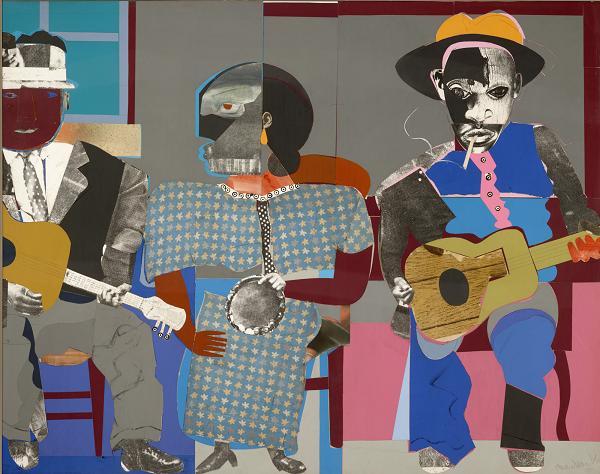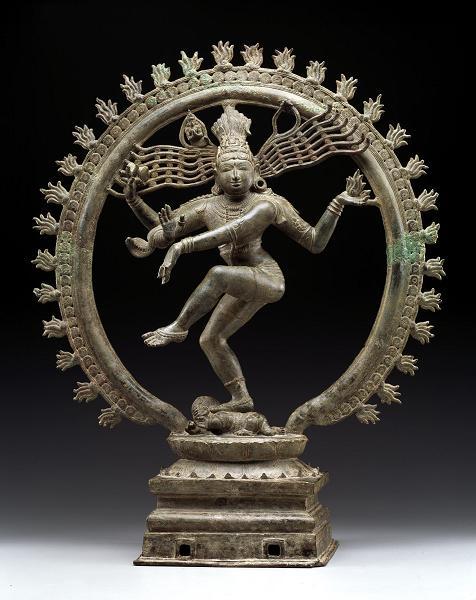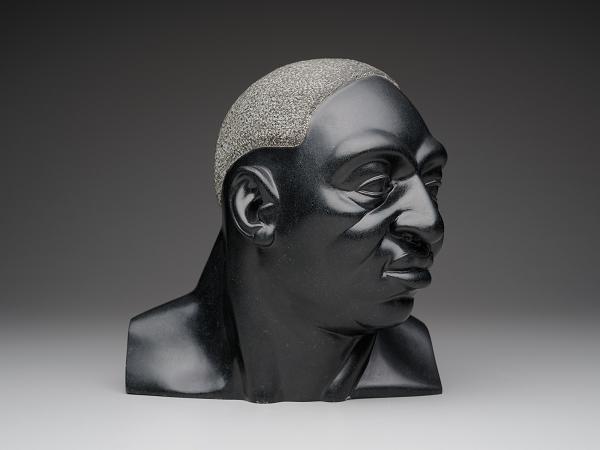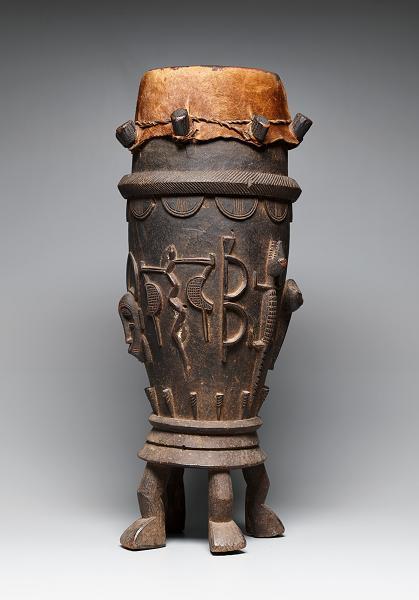The DMA’s collection offers a number of opportunities for cross-disciplinary study. Shannon has written blogs that focus on the literary connections to Abstract Expressionist works of art and other areas of the DMA’s collection. In this post, I thought I could share a few of my favorite music-related objects.
Below is a collage by Romare Bearden called Soul Three. In addition to being an accomplished artist, Romare Bearden also occasionally composed jazz music and associated with musicians such as Branford Marsalis, Duke Ellington, and Fats Waller. This musical influence appears frequently in his collages in the form of musical themes and subjects. Soul Three, for instance, shows three musicians playing guitar and tambourine.
Romare Bearden used music in many ways when he created art. Sometimes he drew while listening to music. He described this experience by saying, “[o]ne of the things I did was to listen to a lot of music. I’d take a sheet of paper and just make lines while I listened to records—a kind of shorthand to pick up the rhythm and the intervals.” Bearden also advised that, in making art, you “become a blues singer—only you sing on the canvas. You improvise—you find the rhythm and catch it good, and structure as you go along—then the song is you.”

Romare Bearden, Soul Three, 1968, Dallas Museum of Art, General Acquisitions Fund and Roberta Coke Camp Fund
Shiva, the Hindu god of creation and destruction, is shown in the bronze sculpture below in his most transcendent state as Nataraja, or Lord of the Dance. Here, Shiva is the embodiment of cosmic energy who dances the rhythm of the universe and beats his drum in time. Music and dance, in the Hindu tradition, are considered pathways to divinity, and worshippers perform to honor the god.

Shiva Nataraja, 11th century, Dallas Museum of Art, gift of Mrs. Eugene McDermott, the Hamon Charitable Foundation, and an anonymous donor in honor of David T. Owsley, with additional funding from The Cecil and Ida Green Foundation and the Cecil and Ida Green Acquisition Fund
Next, this black serpentine bust of Huddie “Leadbelly” Ledbetter shows the musician as he appeared a few years before his death. Leadbelly was a troubled folk singer and two-time murderer who was reputedly pardoned for his crimes when the governor of Texas heard his music. In this bust, he is portrayed sensitively by the sculptor Michael G. Owen, Jr.

Michael G. Owen Jr., Leadbelly, 1943, Dallas Museum of Art, Mr. and Mrs. Tom Gooch Fund Purchase Prize, Twelfth Annual Texas Painting and Sculpture, 1950-1951
Finally, for the Senufo peoples of Côte d’Ivoire, the drum is an instrument of music and communication. Drums are used by Senufo women to accompany songs sung in a secret language to deal with gender conflicts and other frustrations, and serve as a sort of “public address system” for the Senufo community announcing important events or rituals. They are also pounded to create a rhythm which encourages competition among young men hoeing the fields.

Drum, 20th century, Dallas Museum of Art, Foundation for the Arts Collection, gift of Mr. and Mrs. Stanley Marcus
These are only a few of the many works at the DMA which celebrate music. List your favorites in the comments below.
IMLS Grant Coordinator